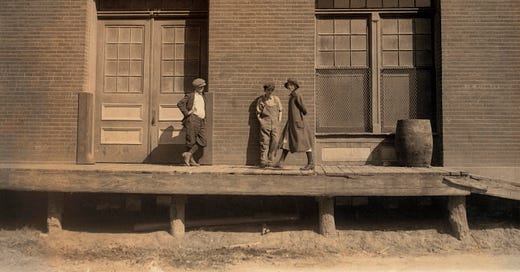Why We Have a Child Labor Problem
We lack the procedures, resources, and political will to protect immigrant children.

A February 25 New York Times exposé on unaccompanied migrant children as young as 12 who end up working in dangerous jobs in meat and food processing plants and on construction sites has sparked widespread outcries from both liberals and conservatives. The Biden administration quickly moved to set up a task force to investigate the flagrant abuse of child labor laws. But the facts in the story should surprise no one. Tragedy doesn’t end for unaccompanied children who come across the border once the government releases them here to family members or other sponsors to await adjudication of their asylum claims. For many, as the report demonstrates, the exploitation and dangers they were fleeing simply follow them, with little hope they can achieve the security and opportunity their families were seeking by sending them north in the first place.
In 2022, the Office of Refugee Resettlement (ORR) received nearly 129,000 referrals from the Department of Homeland Security for children apprehended at the border. ORR’s procedures are complex and depend on a variety of factors, including a quick evaluation of the health and other needs of the children before placing them with a care provider on a temporary basis. On average, children spend 30 days with an ORR care provider, usually a facility operated by an accredited non-profit organization, but the goal is to move them as quickly as possible to live with relatives or foster families.
But even in the best situations, when the child has a close relative to live with, the strains can be difficult. The aunt, uncle, or adult sibling may be living in overcrowded conditions and in financial straits themselves. Unaccompanied children may feel personal and cultural pressure to contribute to household finances, even to send money back to their family at home. Teenagers especially may have left school and started to work (or trying to find work) in their home countries and expect to do the same here, even though American laws forbid it. (How many immigrant teenagers know that schooling is mandatory in America?)
In the worst cases, children may be victims of human traffickers who are using them to extorting money from their families.
The Biden administration’s decision to crack down on employers is certainly appropriate. The Times story described children packing bags of Cheetos and Lucky Charms on assembly lines and tending giant ovens for Chewy and Nature Valley granola bars. Did no one notice these were kids who should have been in school during the day or home sleeping during overnight shifts?
But simply prosecuting employers won’t solve the problems these children face. Too little monitoring occurs when these kids leave direct ORR supervision and too little help is provided to ensure that their basic needs are met, despite ORR’s obligation to provide post-release services to them.
Overwhelmed, ORR is under pressure is to move these children through the system as expeditiously as possible. Vetting of sponsors is minimal, although there are safeguards to ensure that individuals are not serial sponsors who may be part of a trafficking system. The duties of sponsors entail ensuring children show up for their immigration appointments, in addition to providing shelter, food, and clothing, but ORR post-release services that include home visits and other follow-up are limited to the neediest cases and usually end after 90 days. Children placed with relatives or in foster homes may move away after an initial period and the system to track them is haphazard at best. Just as important, unaccompanied children from places like Guatemala, Honduras, and El Salvador—the three top countries of origin—aren’t eligible for the help given to children from Ukraine or Afghanistan, which includes nutrition services including SNAP benefits, medical assistance, and cash benefits. Clearly, the circumstances under which the latter group came here are quite different, but the needs of the children are the same. Politics, not the requisites of a vulnerable population, have dictated the different responses.
What will happen to the kids who lose their jobs when the Biden administration rightly cracks down on employers? It would be naïve to think preventing them from working will automatically make their lives much better. Child labor is cruel, but so too is going hungry or worrying about the deprivations faced by the parent or siblings the unaccompanied child left behind. There are no easy answers.
It would be better if we could ensure the family members waiting for them here had the resources to care for them properly. It would be better if the children stayed in school, and if they must work, that they do so for limited hours with proper working conditions and decent pay. It would be best if families in the Northern Triangle didn’t feel their only option was to send their children to the United States to escape gangs and drug violence or to work in the first place. But in all likelihood, we won’t address these issues because it’s easier to just look away.




